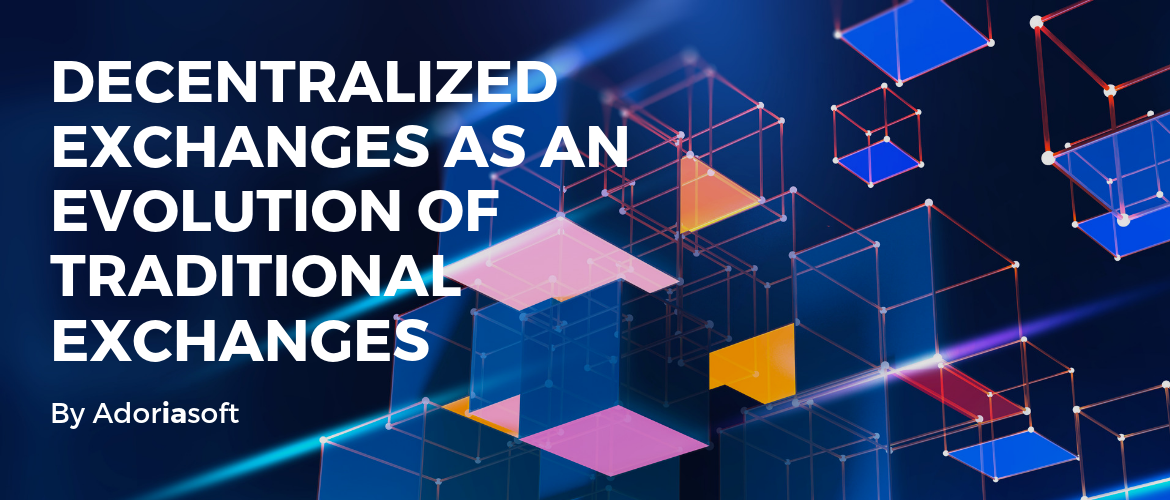Decentralization is one of the pillars on which the concept of blockchain and other distributed ledgers rests. It is one of the main advantages of blockchain – no central authority brings considerable benefits for the users. On the one hand, no middleman means lower costs. On the other hand, no central node means no single vulnerable point that can be attacked to bring down the entire system. Finally, decentralization enables that “trust in a trustless network†where decisions are made by consensus.

However, while blockchain-based networks supporting enterprise or government systems, major cryptocurrencies and custom tokens are mostly decentralized, crypto exchanges, unfortunately, are not. The cryptocurrency exchange platforms, as we know them, are similar to traditional exchanges where various assets are traded. Both have a central authority, or node, that validates the exchange transactions and stores the users’ assets temporarily.
This is their main weakness and one of the reasons why decentralized cryptocurrency exchanges are getting more attention. However, there is more than that, and we are going to take a closer look.
How decentralized cryptocurrency exchanges may solve the problems of centralized ones
The absence of the central authority can indirectly resolve many of the issues that users face when they trade at the centralized cryptocurrency exchanges.
Registration and personal data provision
To trade at a cryptocurrency exchange, you need an account. At the initial stage, you are required to provide just the basic data. For example, Poloniex asks for your name, email, password, and country of residence. Kraken does not want even that – just an email and password would be enough. However, at the basic level, or tier, you cannot do much – you can only look around, and your withdrawals are limited to the minimum. Bittrex prohibits all withdrawals whatsoever if your account is not verified.
To get more freedom, you need to tell the exchange more about yourself – your full name, date of birth, physical address, phone number and, if you want to do some serious trading, you will be requested to upload your photo ID. What the exchange, in fact, does is run a KYC (Know-Your-Customer) check on you. This check is required under the laws of most countries and verifies that the person wishing to trade is who they claim to be and is not involved in anything illegal.
Naturally, KYC is a great mechanism allowing to identify and prevent money laundering, terrorism funding, and many other financial crimes that may be committed on the cryptocurrency market. At the same time, such procedures immediately pin you to your country and place you under their jurisdiction which effectively prevents whole nations from crypto trading (think China).
Decentralized exchanges, in their turn, collect no personal data and require no complicated profiles for each user. This factor makes them truly global and borderless giving traders certain anonymity and privacy. When no personal data is submitted, it cannot be compromised or misused.
At the same time, decentralized exchanges exist in no particular jurisdiction making their users immune to government bans and restrictions.
Verification
However, even if you have filled in all fields, checked all boxes and uploaded all document scans, you cannot start trading large amounts and withdraw them immediately. The exchange needs to verify your data, and in some cases, the verification can take weeks.
Moreover, with crypto trading gaining momentum, exchanges get flooded with new requests that they have no capacity to handle. The registration and verification step becomes a bottleneck stalling the crypto trading for thousands of users. The avalanche-like growth of user numbers can cause other problems resulting in the deterioration of the exchange service.
In December 2017, several cryptocurrency exchanges – Bittrex, Binance, and Bitfinex – were forced to suspend new user registrations as they were unable to handle the sharply increasing demand. Binance and Bitfinex reopened about a month later with Binance limiting the number of new users per day, while Bittrex remained closed for new users for almost four months.
Of course, when new user accounts do not require thorough verification, there is less bureaucracy and no congestion. One more point for decentralized exchanges.
Asset control
This may be the key issue that users are concerned about. When you trade your crypto coins at Kraken or Bittrex, you actually deposit them with the exchange. It keeps them in its wallet and issues an IOU that you can use to withdraw your funds.
With such a procedure, it is the exchange that sets the rules. You, as the user, can only request a withdrawal and then wait helplessly for it to go through. Sometimes, cryptocurrency withdrawals can take up to 12 hours, for example, at Bitfinex, and some exchanges, such as Kraken, charge withdrawal fees. If you want to withdraw your deposit in a fiat currency, it takes even longer – Kraken can process your fiat withdrawal request for up to 5 days.
The withdrawal procedures are also prone to delays due to a high volume of requests. For example, the verification congestion that caused Bittrex to pause new user admissions also resulted in withdrawal delays lasting several days and triggered certain anxiety among its users.
With decentralized exchanges, your crypto money remains with you all the time. The exchange matches your order with another order through a smart contract, and the exchange occurs directly between you and your counterparty. Nothing to deposit, nothing to withdraw, no withdrawal approvals to wait for.
Security

The security concerns are directly related to centralized exchanges being centralized. They operate by storing the users’ assets in their wallets. Obviously, when a popular and successful exchange accumulates a large amount of cryptocurrencies, it is sure to get in the crosshairs of hackers sooner or later.
Several cryptocurrency exchanges have already become targets of attacks and thefts. In January 2018, Coincheck suffered a hack which cost the exchange about $530 million in stolen tokens. It became the largest cryptocurrency hack in the entire history of blockchain pushing the notorious Mt. Gox theft to the second position.
With the users’ funds stored in the exchange wallets, the threat may come not only from the outside, but from the inside, too. Yes, we are talking about exit scams that happen to exchanges, as well. When the cryptocurrency trading business is run by not too honest people, there is a chance that one day, the exchange website closes down and all funds in its wallets disappear.
This happened to MapleChange, a crypto exchange from Canada where the scammers stole about $6 million worth of tokens and crypto coins. MapleChange claimed to have become a hack victim while the community tends to believe that the exchange development team are the guilty ones.
Decentralized exchanges not holding their users’ assets in custody are far less likely to become subjects of attacks, for the simple reason of funds being distributed between users and not held in the same place. Similarly, with no money held by the exchange, the possibility of an exit scam seems extremely remote.
Disadvantages of decentralized exchanges
With all the benefits, there must be some drawbacks, otherwise, we would have had decentralized exchanges all over the place. At the same time, they are just getting on their feet. Indeed, at this stage, decentralized cryptocurrency exchanges still have their issues that may make potential users wary.
Usability and user experience
Centralized exchanges have rather easy trading flows. Basically, the only thing you need to do is create an account, and you can already start trading. The user interfaces are intuitive with everything in the same place. Moreover, such exchanges offer quite serious assistance to inexperienced users in the form of analytical tools or stop-loss order options.
In their turn, the existing decentralized exchanges, such as IDEX or Waves Platform, pass the ball to the user. Their users need to understand how smart contracts work and be able to operate browser extensions, for example, Metamask. For new users, that may be overwhelming. At the same time, decentralized exchange interfaces are often awkward and not intuitive. This may be due to their “infancy†state, but, unfortunately, such deficiencies do not earn popularity with the users.
Low liquidity
Compared to centralized exchanges, their decentralized counterparts have attracted only a small share of the market. Their trading volume is much lower, thus their liquidity is insufficient to support large trading.
The low liquidity causes higher crypto volatility at decentralized exchanges which has a negative effect on the user attraction rate. The situation may change if decentralized platforms improve their user experiences or join forces to achieve higher liquidity.
Low transaction processing speed
With no central entity, transactions need to be approved by the consensus of users through one of the accepted algorithms. This approach may result in significantly longer approval times than at centralized exchanges.
The processing speed issue is not a problem specific to decentralized exchanges only. Most blockchains struggle with it and seek ways to make processing faster. It seems that the Lightning Network allowing fast and inexpensive peer-to-peer transactions may be the answer. Moreover, we can already find examples of crypto exchanges built on top of the Lightning Network, for example, Sparkswap, which is not decentralized in the pure sense of the word but rather belongs to the hybrid type.
What’s in the future?

On the one hand, centralized crypto exchanges face increasingly harder challenges – the scalability problems, hack threats, growing responsibility over the users’ funds. On the other hand, decentralized exchanges are still too young to claim the market. At the same time, they seem to be the next step in the evolution of the crypto ecosystem and, with certain improvements, may replace centralized ones.
At the same time, the pressure from the governments is going to increase, not only for the purpose of taxation but for the need to prevent financial crime and terrorism sponsoring. Therefore, centralized and decentralized exchanges should find some middle ground in these matters so that not to end up completely outside the law.
The Adoriasoft team avidly follows the cryptocurrency exchange market trends and does constant research on the new technologies and approaches. As building crypto exchanges is one of our services, we are doing our own analysis of centralized and decentralized exchanges, as well, because we can develop both types.
We believe that decentralized exchanges have more potential as to handling the demand in the conditions of the crypto market growing exponentially. Thus, we invested a lot in learning the corresponding technologies and can help businesses start secure and effective crypto exchanges. To begin, contact us for a free consultation on your project, and we will work out the solution that is the best for you.
